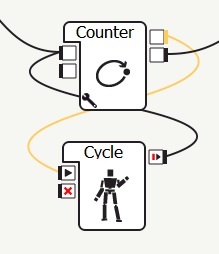Lesson Modules
Teaching Tips:
DO THE ROBOT
Problem of the Day:
How do I make NAO do more than one thing at a time?
Vocab:
- Rate
- Frame
- Cycle
- Action
Make NAO do two looped actions at once using parallel processing and be able to figure out which action will finish first.
Content
Students will solve rate problems using multiplication and addition with decimals.
Learning Overview:
- Intro: Students will follow NAO in a dance
- Problem Solving: Students will figure out which loop will finish first.
- Creative Time: - Students will use what they learned to have two actions running in parallel.
- Reflection: The class will discuss what they learned and show off their creations.
Download the Choregraphe files onto your computer
Load Lesson4_1 Choregraphe File onto one of the robots. Give the robot at least 2 feet on all sides to do his dance. Clear a space for students to gather and watch the NAO. They will be mirroring NAO’s movements, so be sure to leave enough space for them to move!--next section--
Get the students to stand arms-distance apart. Have the students follow NAO in a dance.
BEFORE THE CLASS
First, wash your hands. Make this a daily routine. The robots are white and get dirty easily.
OBSERVATION
You will be mirroring NAO's movements, so be sure to clear a space for everyone. Listen carefully what your teacher will explain and follow the direction.
Teaching Tips:
PROBLEM SOLVING
Introduction (5 minutes)
Explain to students that the goal of this lesson is to investigate what happens when you run two looped actions at the same time. How does the robot deal with this?
Student Discovery (5 minutes)
Have a volunteer read out the problem on the “Make a Plan!” page. Then have students fill out the plan organizer. When they are done, discuss ideas as a class.
Calculating Time (5 minutes)
Have the students fill out the “Calculating Time!” page in the student book. Discuss responses (answers in reference sheet).
Solve the Problem (5 minutes)
Have the students fill out the “Solve The Problem” page in their student book. Discuss responses. See answers in reference sheet.
MAKE A PLAN
"I want NAO to do more than one thing at a time!"
Read the problem below and fill out the plan diagram. You do not need to solve the problem now. Solving this problem is the goal of this lesson.
The Problem

Look at the program above.
The Robot Arms timeline lasts 18 frames and is looped 2 times.
The Robot Head timeline lasts 15 frames and is looped 3 times.
Problem to Solve: Which action will finish first?
Draw a picture of what you want NAO to do and Look for Choregraphe Boxes that might be helpful in solving this problem.
--next section--
CALCULATING TIME
Refer to the pictures to answer the questions. Show any calculations.

-- next section----
The Problem:

Look at the program above.
The Robot Arms timeline lasts 18 frames and is looped 2 times.
The Robot Head timeline lasts 15 frames and is looped 3 times.
Problem to Solve: Which action will finish first?
Action 1:
Action 2:
Teaching Tips:
CREATIVE TIME
See the Lesson4_2 Choregraphe file for an example.
Plan (10 minutes)
Have the students fill out the “My Dance!” page in their student book.
Implement (20 minutes)
Students program their robot to do the dance they planned. Be sure to sketch the program
MY DANCE
Action 1:

My first action will loop times.
One cycle will take frames.
In total, the action will take frames.
Here is a sketch of what NAO will do...
Sketch:

Action 2:

My second action will loop times.
One cycle will take frames.
In total, the action will take frames.
Here is a sketch of what NAO will do...
Sketch:
Teaching Tips:
Reflection (5 minutes)
Have the students fill out the “Reflect” page. Give them 2 minutes to journal silently. Then have them volunteer their responses to help stem a discussion.
After the Lesson:
- Transfer the students’ Choregraphe files onto the thumb drive and delete the file from the computer.
- Pack up the NAO’s, computers and router.
-- next section--
- Transfer your Choregraphe files onto the thumb drive from your teacher and delete the file from the computer.
- Help your teacher packing up the NAO robot computers and router with an extreme care.

